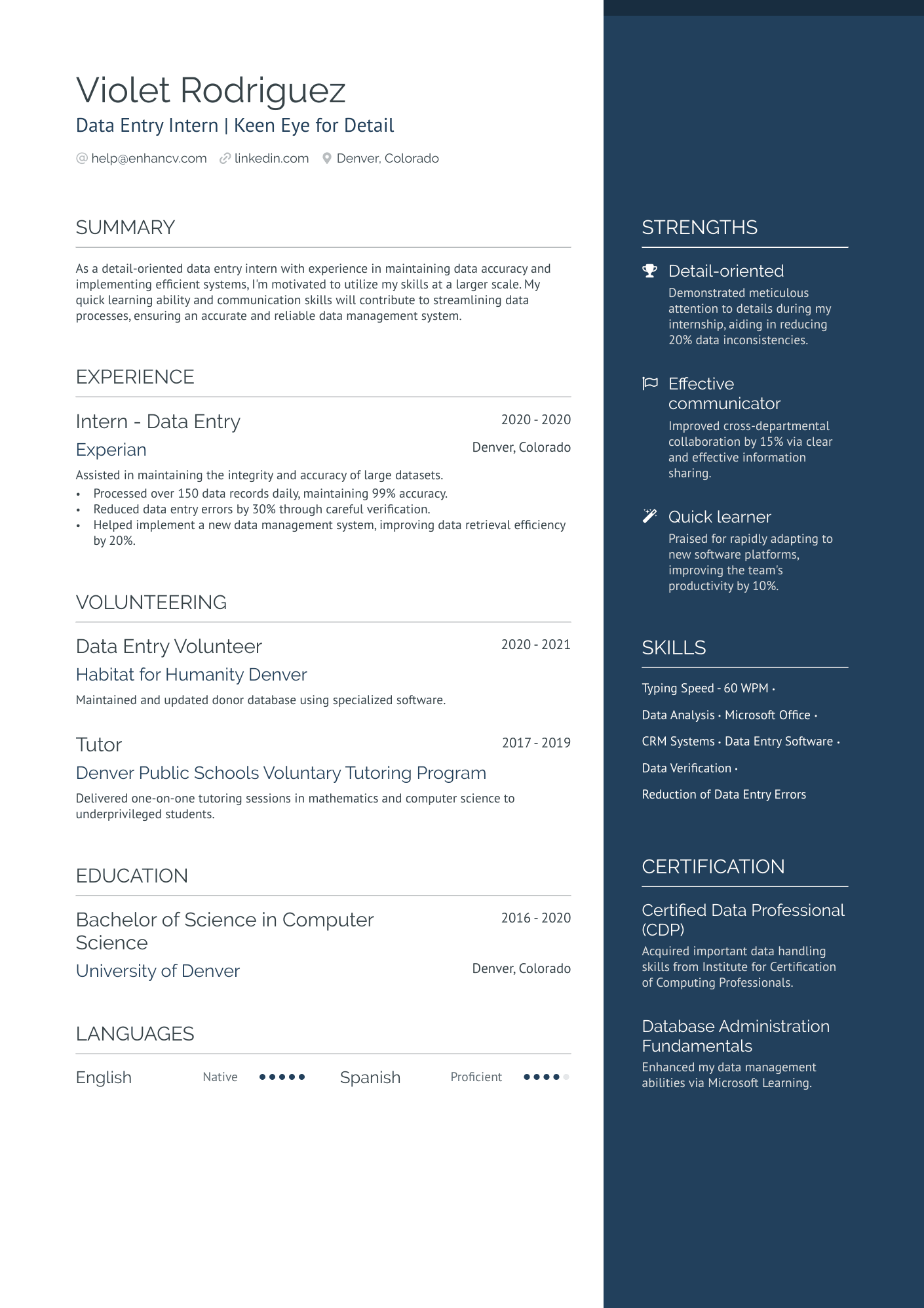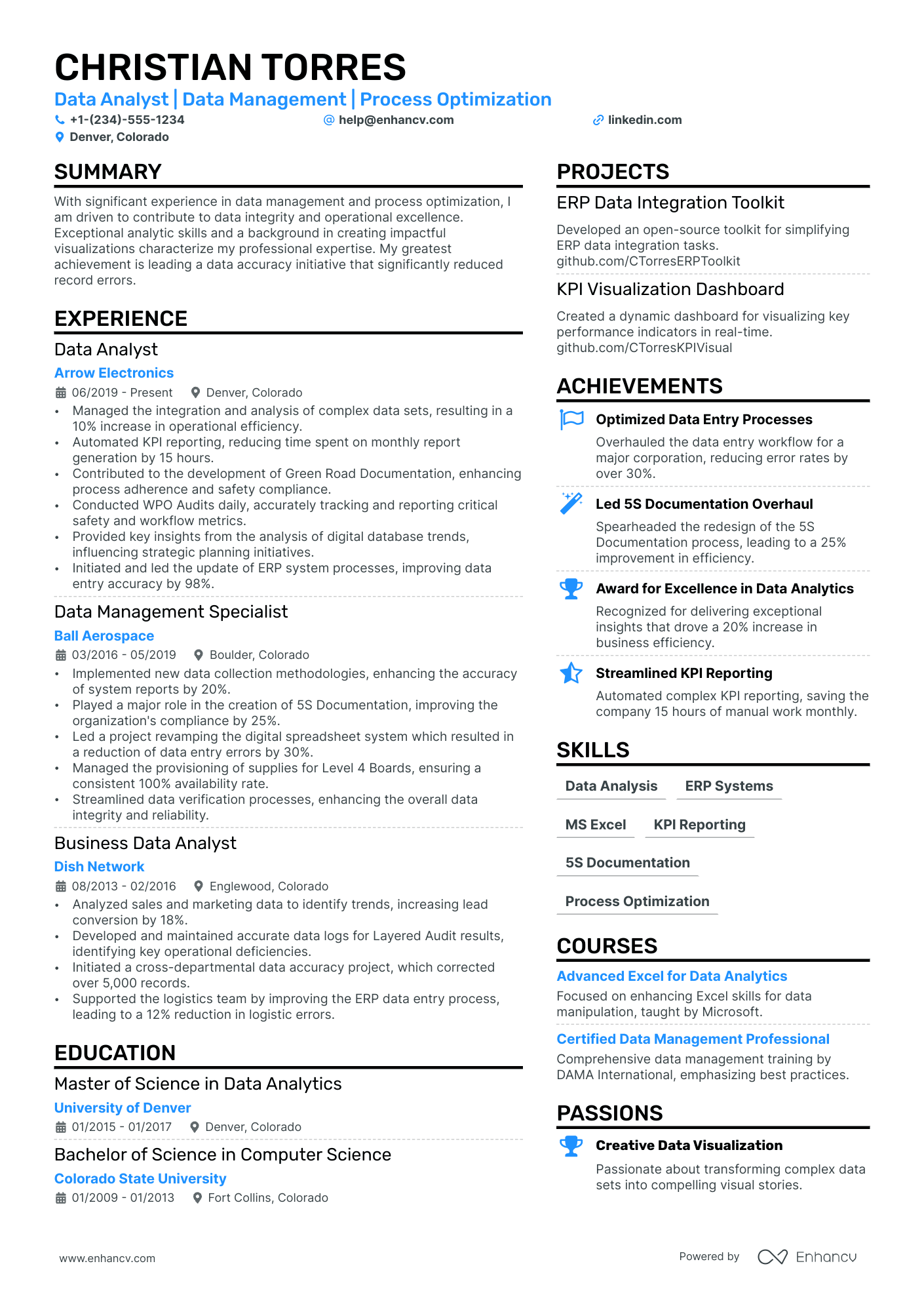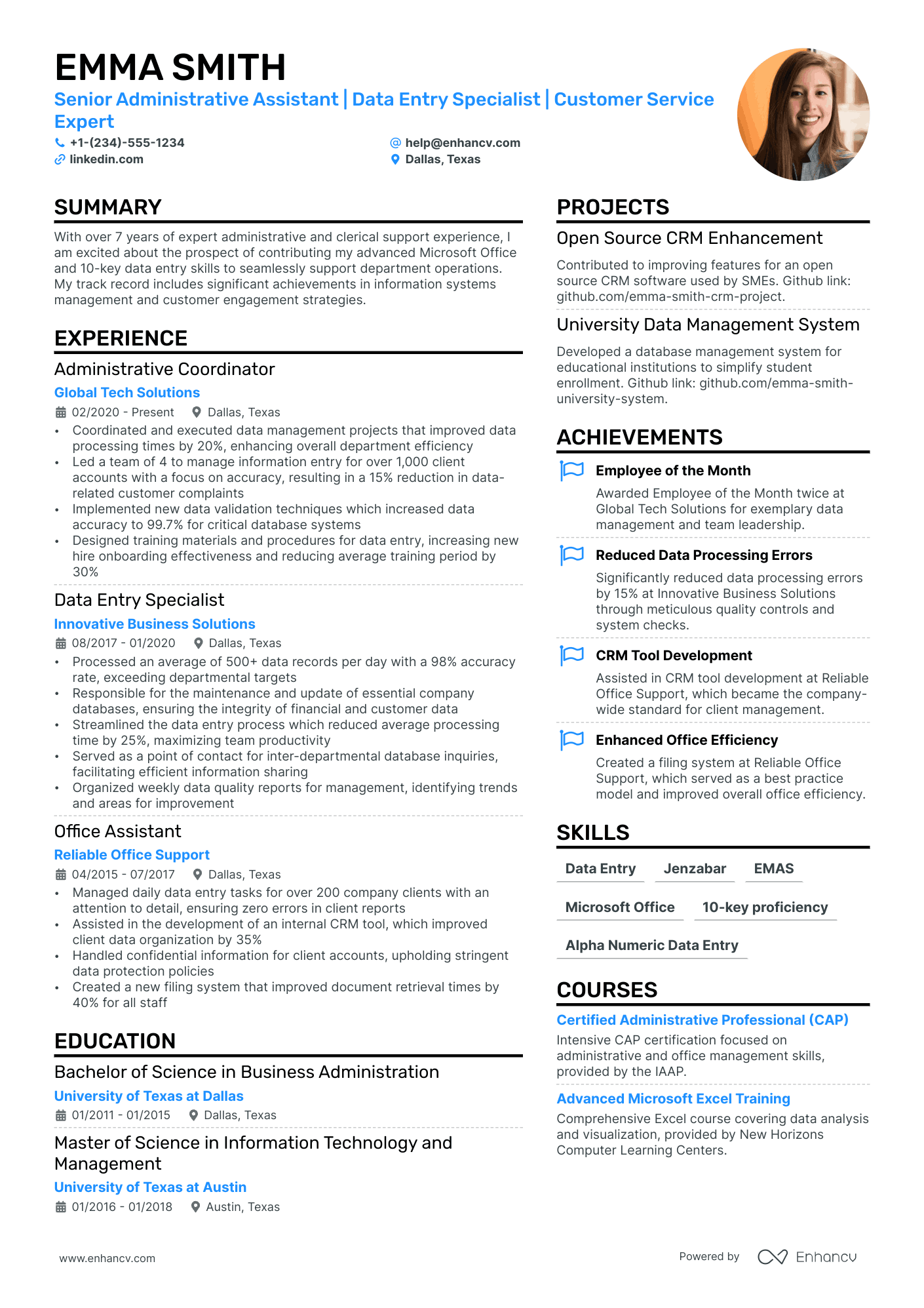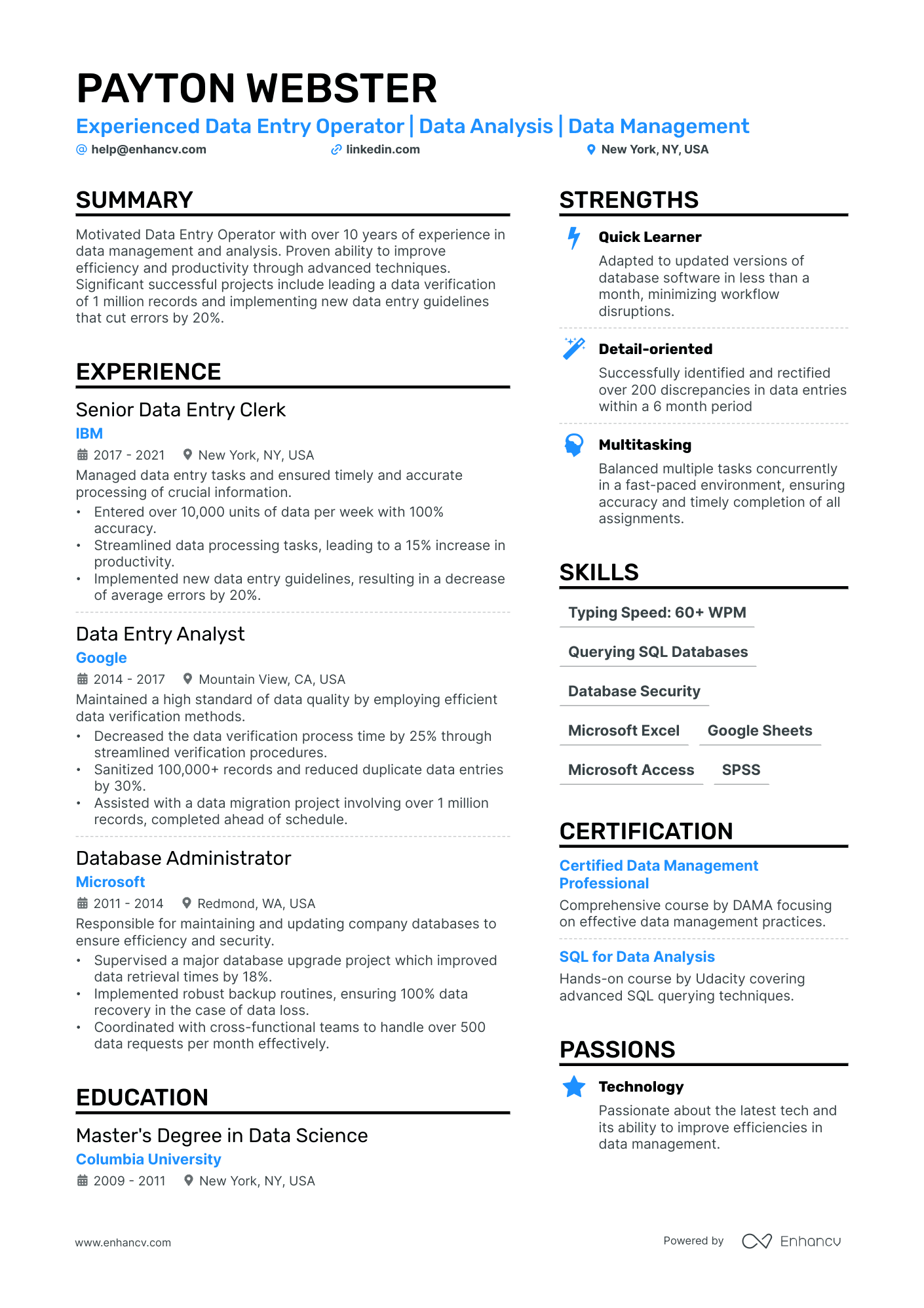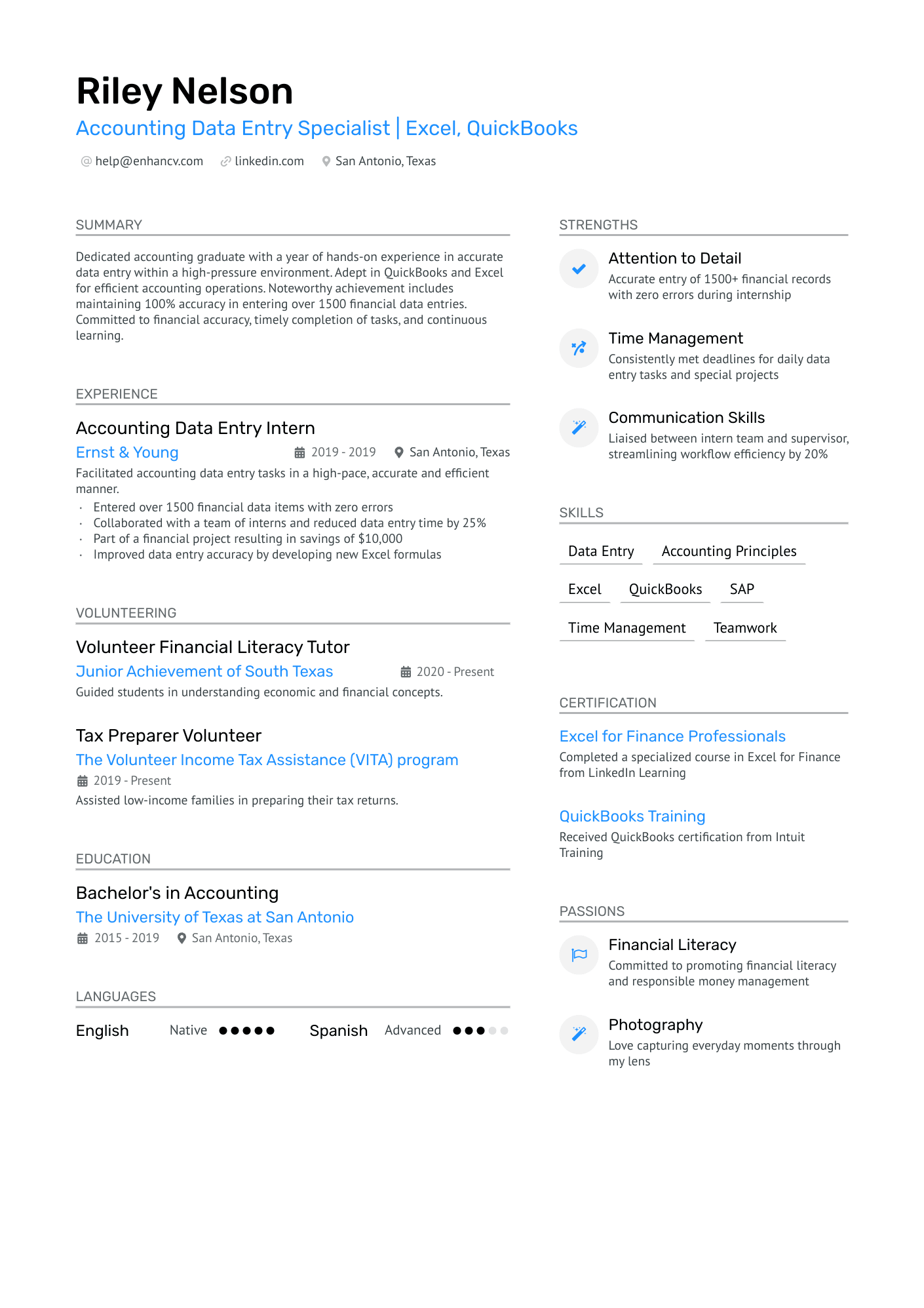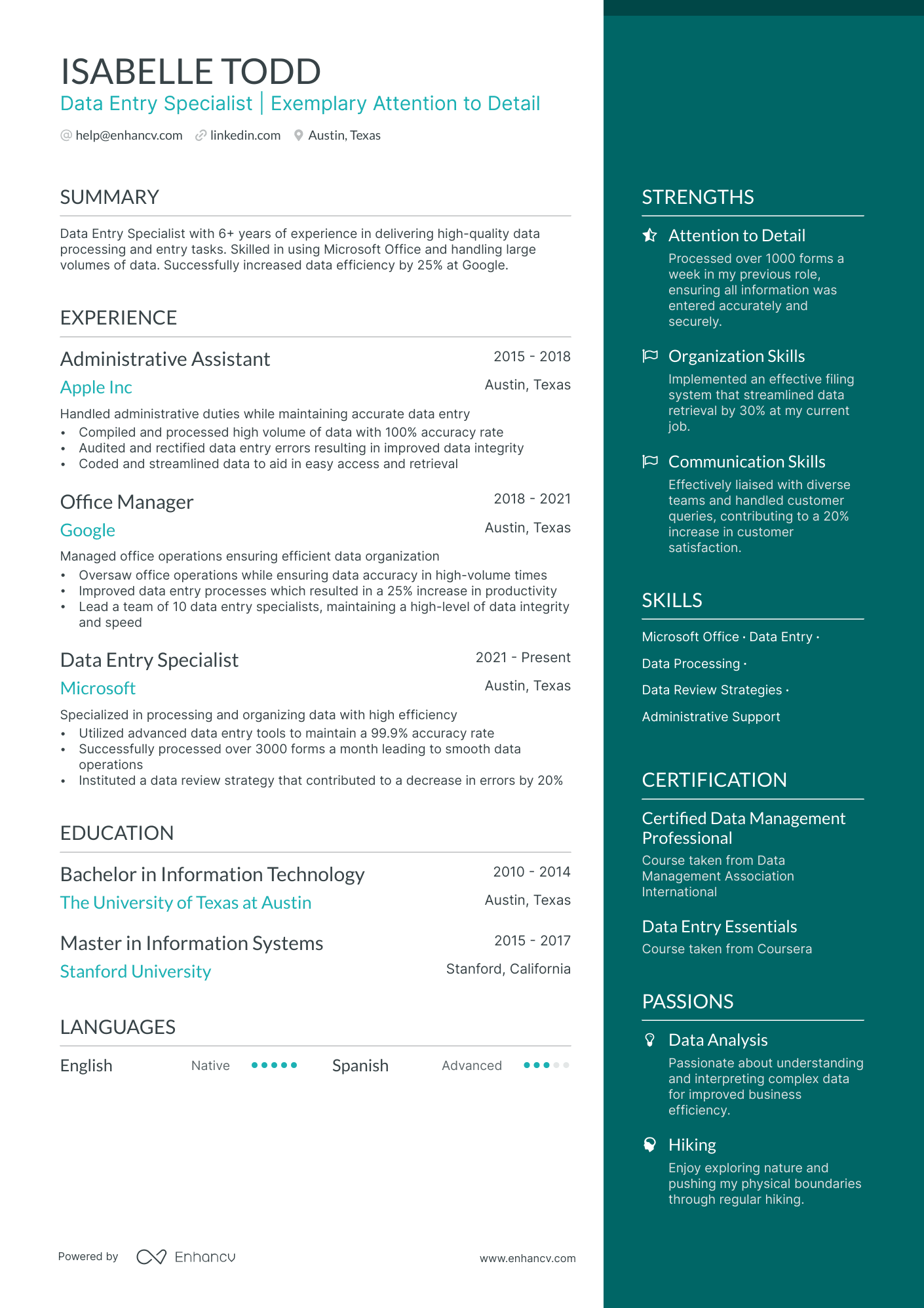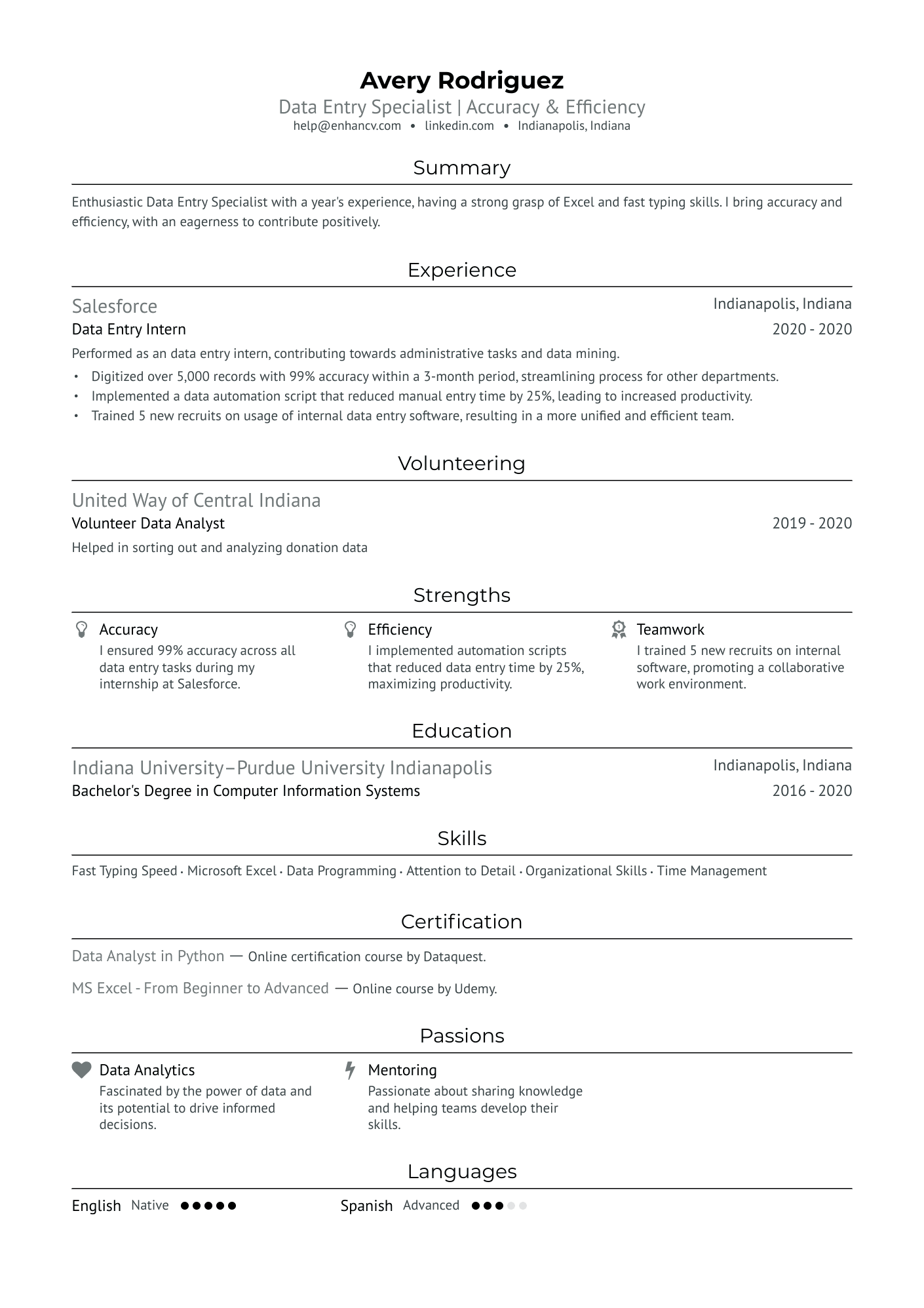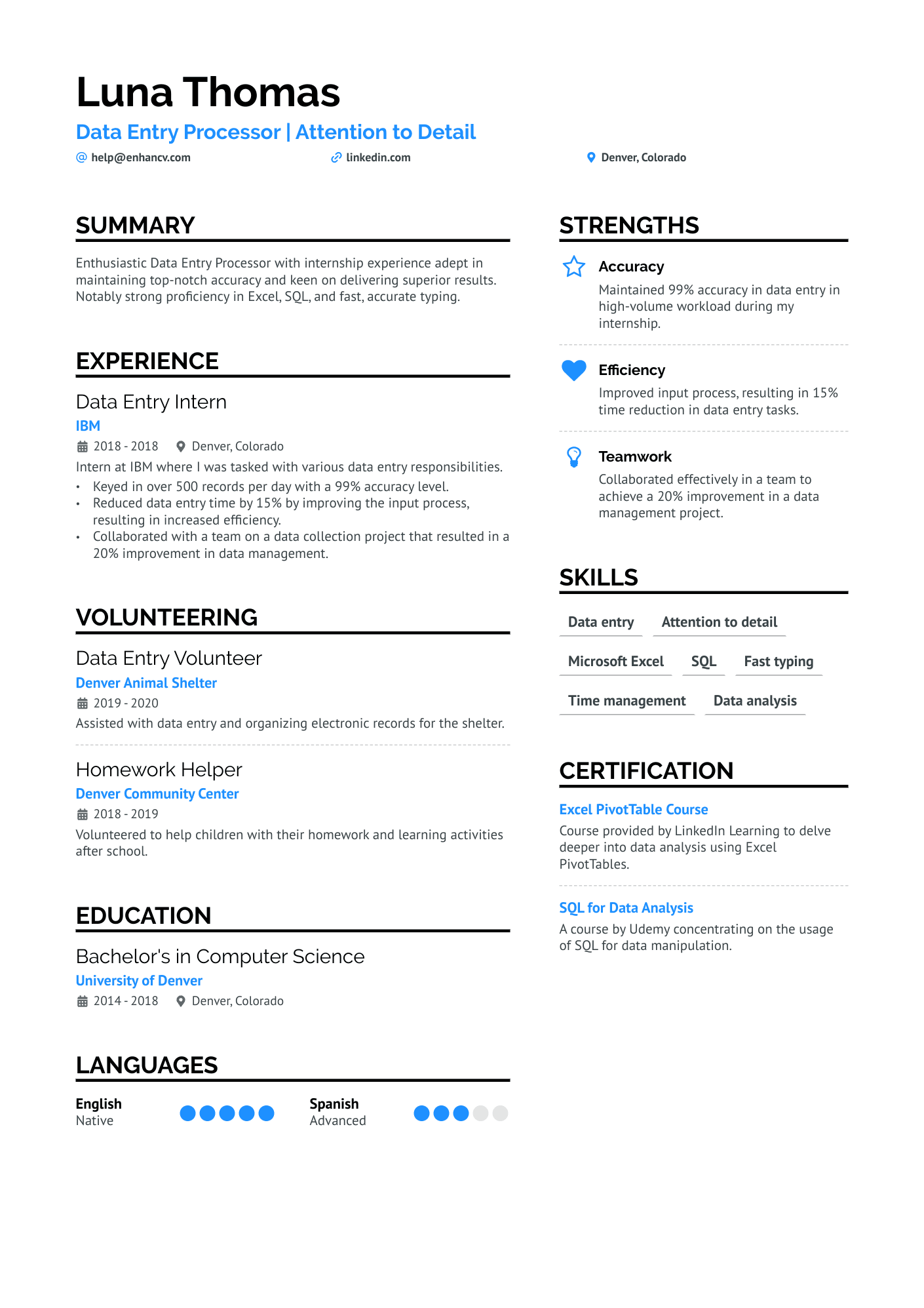Data entry professionals operate across all sectors and have specific expertise. Although the work involves repetitive tasks that can quickly become monotonous, securing a dedicated data entry role in today's technology-driven job market is also challenging, as it often requires a broader set of skills. Don't worry though because with your fast typing skills and keen attention to detail, you're off to a strong start.
The main hurdle? Impressing the hiring managers quickly. Have you heard about the 7-second rule in resume evaluation? That's right! A resume has a brief 7-second window to catch a hiring manager's attention. It goes beyond simply displaying technical skills. It's about demonstrating your ability to collaborate effectively with a team or manage tasks independently.
This guide will help you create a data entry resume that highlights your strengths and shows you're right for the job.
What you will learn from this data entry resume guide:
- How you should format your resume for the biggest impact
- Which sections should be included in your data entry resume?
- What are the key highlights of a data entry summary?
- How can you describe your work experience in a way that captures recruiters' attention?
- What is the best mix of hard and soft skills to include in your data entry resume?
If you're interested in other data management roles related to data management, we have other options available as well.
- Business Data Analyst Resume
- Data Analyst Entry Level Resume
- Data Mining Resume
- Data Engineer Resume
- Executive Assistant Resume
- Office Assistant Resume
- Secretary Resume
How to format a data entry resume
If you have experience in data entry, using the reverse-chronological resume format is highly recommended. This approach showcases your career growth and notable achievements in different data entry roles or organizations.
Those new to data entry might benefit from a functional resume format or a hybrid layout, both of which emphasize skills and strengths over chronological work history.
Choosing an effective resume design is crucial for standing out from the competition. Our professionally designed resume templates provide a modern appearance that captures attention immediately.
When preparing your data entry resume, consider these guidelines:
- Include your contact details, specifically your email address, phone number, and current location in the header section.
- Select a PDF file instead of a Word document to ensure the layout remains consistent across all devices.
- Maintain 1-inch margins around your resume for a clean and readable presentation.
- Pick colors for the resume that suggest professionalism like green for example. Green will load your data entry resume with a growth-focused vibe.
- Choose professional fonts like Rubik, Volkhov, or Montserrat, with a size range of 10 to 12 points for clarity.
In the United States, having a photo on your resume isn't the norm, nor is it mandatory, so to avoid bias and discrimination, opting for a resume without a photo is your safest bet.
The path to a data entry position is competitive and requires multiple skills. If you already have a data entry resume, run it through our free AI resume checker for personalized improvement tips.
Is your resume good enough?
Drop your resume here or choose a file. PDF & DOCX only. Max 2MB file size.
To properly organize your resume for a data entry role, make sure to follow formatting practices that spotlight key sections effectively.
The top sections on a data entry resume:
- Contact information: This section is crucial for employers to know who you are and how to reach you.
- Career goals: Use this to present your career intentions and their fit with the requirements of the data entry role. You can include this in your summary or objective section.
- Skill set: Highlight your data entry skills, such as typing speed, accuracy, and software proficiency, that make you a strong candidate for the job.
- Work experience: Hiring managers rely on this information to understand your former roles in data entry, including tasks, responsibilities, and the knowledge you've acquired.
- Education and certifications: Include this to underline your relevant education or certification such as a degree or a data entry certificate, enhancing your credibility for the job.
When customizing your resume for a data entry position, put the focus on what sets you apart. Recruiters want to know how you'd contribute to their data team.
What recruiters want to see on your resume:
- Precision and accuracy: These qualities are fundamental for a data entry role as errors can impact company operations or management decisions.
- Speed: Recruiters prioritize applicants who can input data quickly because it increases productivity and efficiency.
- Familiarity with software: Knowing how to use data entry tools reduces the learning curve and training time.
- Confidentiality: This is crucial because data entry keyers often handle sensitive and confidential data.
- Problem-solving skills: Often, data may have issues such as duplication or discrepancies, and proficiency in addressing these assets is a plus.
With our basics set, let's put the lights on your work experience section in the resume.
How to write your data entry resume experience
In your data entry resume, the experience section is pivotal and serves as the main area where recruiters determine if your past roles align with the needs of the role at hand. They're on the lookout for concrete results and the impact you've made in previous positions. Emphasizing measurable achievements and key performance indicators is crucial.
To prove suitability for the position, you need to present clear evidence of actual outcomes. Aim to highlight three to four notable achievements for each job and focus on your results rather than just listing tasks. Skip the buzzwords, because they won't help you here.
Look at these two examples of an identical data entry position. The first gives a broad overview and shows how not to write it. The second example focuses on precise, measurable achievements.
- •Involved in various data entry and maintenance tasks, contributing to overall data quality
- •Participated in routine data operations, aiding in the efficiency of data handling processes
- •Engaged in data strategy activities, enhancing the organization's data management practices.
The example is not ideal for several reasons:
- It's too general and lacks details about what exactly was done.
- There are no specific results or numbers to show success.
- It fails to highlight any special skills or software proficiency.
- It doesn't show personal growth or how challenges were overcome.
A little fine-tuning here would better display the candidate's industry strengths and personal wins.
- •Processed over 1,000 data entries per day with 99.9% accuracy, significantly enhancing data quality for client projects.
- •Implemented a new data validation technique that reduced processing errors by 20%, improving overall operational efficiency.
- •Led a project to digitize 5 years’ worth of paper records into the database, boosting data accessibility and reducing retrieval time by 40%.
The second example is superior because:
- Lists concrete, quantifiable results (like processing speed and accuracy), directly showcasing abilities.
- Uses numbers to illustrate the impact, making the success tangible.
- Highlights specific skills and improvements made, such as error reduction and efficiency gains.
- Shows involvement in significant projects, indicating leadership and initiative.
Data entry clerks should focus on demonstrating their fast typing, meticulous accuracy, and software proficiency. Tailor your resume to meet ATS (Applicant Tracking System) requirements, as these systems filter resumes based on job-related keywords.
Also, you need to think about how long your resume should be. Whether you choose a shorter one-page resume format or a detailed two-pager option depends on which of them best showcases your skills and strengths.
A resume that's too long can hurt your chances. Going beyond two pages turns off 17% of hiring managers, and in the business world, a resume with over 600 words drops your hiring chances by 72%. So, keeping it short and to the point is important.
Next, we'll explore how to point out your data entry achievements on a resume with numbers and metrics that truly stand out.
How to quantify impact on your resume
- Quantify your proficiency in different software like Excel or QuickBooks to verify your technical skills.
- Offer a measure of the data amount you've handled to demonstrate your ability to manage large volumes of data.
- Indicate your accuracy rates to give a clear picture of your precision, because it's a vital attribute in data entry and management.
- Display the number of deadlines you met successfully to show your time management and reliability.
- Describe how many projects you've worked on to illustrate your experience.
- State the number of data entry or relevant software certifications you possess to emphasize your commitment to professional development.
- If you have helped in reducing error rates in previous roles, mention this to validate your attention to detail and error correction abilities.
How do I write a data entry resume with no experience
If you're entering data entry with limited work experience, emphasize your fast typing speed, software knowledge, and any data-related tasks you've handled in volunteer roles or school projects.
Even in university, you have a chance to find a position that includes data entry work. There are positions in admissions, the individual school and department units (especially R&D), and in alumni relations. A starting career job like this most probably would be a combination of straight data entry, some analysis, and some data loads.
Now let's check some practical tips on how to boost your data entry resume.
- Objective section: Craft a brief statement that conveys your enthusiasm for data entry, summarizes your past involvement in the field, and defines your career aspirations. Ensure that recruiters understand how your objectives align with the goals of their organization. You can gain some ideas from the job description.
- Skills: List your relevant data entry skills, including technical skills (typing speed, familiarity with data management software like Microsoft Excel and Access) and soft skills (attention to detail, organizational abilities). Highlight how these skills, acquired through academic work, projects, or self-learning, position you as a good candidate for the data entry job you're targeting.
- Work experience section: Think about adding as many relatable things to your experience section as possible. It doesn't matter if the earlier job wasn't related to data. For example, if you did some data-related things in your previous job, focus on that rather than adding your main responsibilities that don't relate. Also, try to do some courses or a bootcamp to gain more experience there.
- Education section: Mention your degree and major, plus any certifications specifically related to data management or IT skills.
- Projects: Point out any freelance data entry tasks or personal projects that display your data handling capabilities.
- Internships: Feature any internships focused on data processing or management. These experiences underline your direct engagement with the field and your proactive approach to applying data-related skills.
Include your graduation date to emphasize your academic background and its relevance to a data entry position. If you have a strong GPA, adding it to your resume can showcase your academic success. Remember, in data entry, precision and organizational skills are just as crucial as technical know-how.
How to list your hard skills and soft skills on your resume
Skills are vital for your data entry resume. Recruiters want to see what you can do and why you're a good fit for their position. Make sure to mention all data entry software and tools you're skilled in.
Let's check some of the best hard skills for this position.
Best hard skills for your data entry resume
- MS Office
- Microsoft Excel Proficiency
- Typing speed
- Accuracy
- Writing reports
- Google sheets usage
- Familiarity with CRM systems
- Knowledge of data entry software
- Ability to use database management
- Familiarity with QuickBooks
- Proficiency in SQL
- SAS Programming skills
- Understanding of Oracle
- Mastery of SPSS
- Knowledge of Tableau
- Familiarity with data warehousing solutions
Let's now proceed to soft skills and don't worry if you're not so good at communication. Introverts fit in perfectly with data entry roles because they spend most of their time working on projects alone. There's a little bit of teamwork involved, where you might ask for a second opinion or decide on the best approach to a task. Plus, another 5-10% involves coordinating with different parts of the organization. It's a great setup for those who like quiet, focused work but still engage in some collaboration.
Best soft skills for your data entry resume
- Detail-oriented
- Organization
- Self-motivation
- Time management
- Adaptability
- Remote work skills
- Patience
- Collaboration
- Problem-solving
- Proactivity
- Reliability
- Confidentiality
- Diligence
- Customer service skills
PRO TIP
US employers prefer resumes that are specifically tailored for the job you're applying for, rather than a generic one. Making a resume just for that particular data entry job can really help you get it.
How to list your certifications and education on your resume
To be considered for a data entry role, you often need a high school diploma or equivalent, but additional qualifications can make you stand out. Here's how you should organize your education section.
What to include:
- Degree name: Specify the degree you have.
- Institution name: Name the place where you got your education.
- Graduation date: When you graduated or when you expect to graduate.
- Field of study: If applicable, mention your field of study, especially if it's related to data management or IT.
- Certifications: List any certificates you obtained related to data entry.
- GPA: Include your GPA if it's high and you've graduated recently.
Here’s an example:
- •Core Modules: Basic computing, data entry practices, and information systems management
Adding certifications to your resume, apart from your school or college education, such as in managing data, using different software, or protecting information online, shows you're ready to learn and evolve.
Here we suggest five certifications valuable for data entry roles.
Best certifications for your data entry resume
Next, we explore the difference between a resume summary and objective and figure out the best situations to use either of them.
How to write your data entry resume summary or objective
Building an impactful resume summary or objective for data entry roles requires you to concisely showcase your strengths, work history, and what you can offer. Selecting a summary or objective depends on your career background and targets. Here’s how to proceed with each option:
Resume summary
A resume summary is ideal for data entry specialists with several years of experience. It should showcase your career successes, essential skills, and how you can contribute to the employer's needs.
Resume objective
A resume objective is suitable for those new to data entry or changing their career path. It centers on your goals, relevant skills, and how you plan to develop while contributing to the prospective employer.
Tips for writing your summary or objective:
- Customize: Make your summary or objective specific to the data entry job and company you're applying for to show how your abilities and past work align with the job requirements.
- Mark successes: Whenever possible, use numbers or results to show your contributions in past positions (e.g., "successfully completing over 250 projects").
- Concentrate on skills and tools: Highlight particular data entry skills and software you're skilled in, especially those mentioned in the job ad.
- Write on point: Aim for a brief 3-4 sentences that effectively summarize your professional experience or goals.
A well-crafted and focused summary or objective can make a strong first impression on your resume, so it's worth taking the time to perfect it!
Additional sections for a data entry resume
To enrich your data entry resume, include specific sections that reveal a wider array of skills and enthusiasm. Beyond the standard professional experience, academic history, and certifications, think of adding these sections as well:
- Projects: Emphasize your engagement in significant data management projects during college or university, specifying your contributions and the project outcomes.
- Training/Courses: Mention any courses you've taken that helped you get better at things like SQL optimization and database security for example.
- Passions: Sharing hobbies like coding, puzzles, or organizing community events can illustrate a well-balanced character.
- Language skills: Highlight your language abilities to show you can handle data from different regions or communicate effectively in a multilingual team environment.
Key takeaways
- Emphasize your typing speed, accuracy, and efficiency as a data entry specialist (using real numbers to back up your claims).
- Choose a professional resume template that will immediately grab attention. Details like layout consistency across devices, professional colors, and modern fonts contribute to making a resume stand out.
- Essential sections include contact information, skill sets, work experience, and education/certifications. Together, these elements offer a detailed snapshot of what you bring to the table.
- Tailor your resume to every job you apply for, mirroring the same keywords they use in the job description and the responsibilities of the role.
- Keep the format easy to read and organized for the highest impact, including using bolded headings and bullet points.
Data Entry resume examples
Explore additional data entry resume samples and guides and see what works for your level of experience or role.
By Experience
Entry-Level Data Entry
By Role
